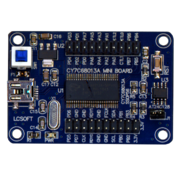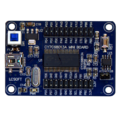Lcsoft Mini Board
 | |
| Status | supported |
|---|---|
| Source code | fx2lafw |
| Channels | 8/16 |
| Samplerate | 24MHz |
| Samplerate (state) | — |
| Triggers | none (SW-only) |
| Min/max voltage | -0.5V — 5.25V |
| Threshold voltage | Fixed: VIH=2.0V—5.25V, VIL=-0.5V—0.8V |
| Memory | none |
| Compression | none |
| Website | lctech-inc.com, geeetech.com |
The Lcsoft CY7C68013A Mini Board is a Cypress FX2(LP) eval board, which can be used as USB-based, 16-channel logic analyzer with up to 24MHz sampling rate.
It is a clone of the Saleae Logic.
In sigrok, we use the open-source fx2lafw firmware for this logic analyzer.
See Lcsoft Mini Board/Info for some more details (such as lsusb -v output) on the device.
There is a very similar board made by Geeetech, it has near-identical components but a slightly different layout.
Hardware
- Main chip: Cypress CY7C68013A-56PVXC (FX2LP)
- 3.3V voltage regulator: Advanced Monolithic Systems ASM1117-3.3
- 16kB I2C EEPROM: Atmel AT24C128A
- 24MHz crystal: JY24.0000601
All the pins on the FX2(LP) are broken out to 40 header pins. There's an on/off toggle switch, a reset button, and a jumper that lets you select whether the FX2LP gets its configuration from a small EEPROM, or boots into the default mode. The EEPROM is usually provided programmed such that it enumerates with the same VID:PID as a Saleae Logic.
The flash can be programmed with the 8ch lafw firmware, allowing you to switch between 8ch and load-on-probe 16ch firmware with the jumper
Photos
Geeetech version:
Differences from the LCSoft board:
- two LEDs, on pins PA0 and PA1
- two jumpers: J1 connects/disconnects the LEDs from Vcc, J2 sets the EEPROM address bit A0
- construction quality is higher
The Geeetech board's J2 is logically opposite to the LCSoft board's jumper: pin A0 is tied HIGH via a 10kOhm resistor, inserting J2 pulls it LOW. i.e. inserting J2 on the Geeetech is functionally the same as removing the jumper on the LCSoft board.
Protocol
Since we use the open-source fx2lafw firmware for this device, we don't need to know the protocol.
Possible issues
- With some kernel versions, and if the onboard EEPROM is disconnected (the jumper not connected) the kernel will automatically claim the device with a usbtest kernel module, seen in dmesg like usbtest 2-2:1.0: FX2 device — if this happens, sigrok will be unable to claim the device. Remove the usbtest kernel module as root to be able to use it:
$ sudo rmmod usbtest
You can add the usbtest module to a module blacklist permanently, at least in Debian-based distributions found in /etc/modprobe.d/blacklist.conf:
$ sudo sh -c "echo 'blacklist usbtest' >> /etc/modprobe.d/blacklist.conf"
Required testing hardware extensions
Do not directly hook the board pins to another circuit, if you don't know what you are doing! This could damage the board!
The simplest circuit would be adding at least resistors in between your circuit-in-test and the Lcsoft board, but be aware here that the Cypress FX2(LP) chip can only tolerate a maximum of 5V I/O. Better would be to use a clamp circuit like shown at Spiralbrain's Blog (but you do not need to add another EEPROM for sigrok with fx2lafw!). A buffer circuit using a 74HC241 IC for protection is also possible. Check the fx2lafw page to see which protection circuits are used on other logic analyzer boards.
More information can be found in Circuits for barebone boards.








